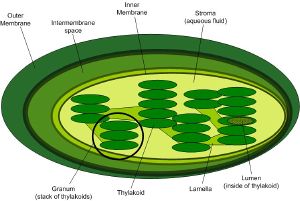Chloroplast
Chloroplasts are organelles (compartments) found in plant cells and eukaryotic algae that conduct photosynthesis.
Utilizing chlorophyll and water, chloroplasts capture light energy from the sun to produce the free energy stored in ATP and NADPH through a process called photosynthesis. The photosynthetic mechanism also produces food for the organism in the form of sugar. In the process of creating sugar, carbon dioxide is consumed and oxygen is released. The simplified overall equation can be depicted as:
- 6 CO2 + 6H2O + light â C6H12O6 + 6 O2
- Carbon Dioxide + Water + Light energy â Glucose + Oxygen
As the source of all photosynthesis, the chloroplast serves a larger purpose by providing food for the entire plant or algae, and by extension for those organisms that consume these autotrophs.
The theorized origin of chloroplastsâdeveloped through a mutually-beneficial symbiotic relationship between a cyanobacteria and a prokaryoteâreflects a view, advocated by Lynn Margulis, that life developed more through cooperation than through competition. (See mitochondrion.)
The term chloroplast is derived from the Greek words chloros which means "green" and plast which means "form" ( in biological terms, it can be more roughly translated as organelle or cell ).
Structure and function
Chloroplasts are flat discs usually two to ten micrometers (Îźm) in diameter and one micrometer thick. The chloroplast has a two membrane envelope termed the inner membrane and outer membrane, respectively. Between these two layers is the intermembrane space.
The fluid within the chloroplast is called the stroma. Although most of the chloroplast's proteins are encoded by genes contained in the cell nucleus, some small portion of them are produced from tiny circular DNA and ribosomes present in the stroma, which corresponds to the cytoplasm of the bacterium.
Within the stroma also are stacks of thylakoids, the sub-organelles where photosynthesis actually takes place. A stack of thylakoids is called a granum (plural: grana). A thylakoid looks like a flattened disk with an an empty inside region called the thylakoid space or lumen. The photosynthesis reaction takes place on the membrane of the thylakoid, and, as is also the case with mitochondria, utilizes the coupling of cross-membrane fluxes in a process to produce a new biological product. For photosynthesis, that product is both ATP and sugar.
Embedded in the thylakoid membrane is a dish of chlorophyll molecules known as an antenna complex. This outer array helps to increase the surface area of light capture. The light photons are then funneled to the center of this complex. Two chlorophyll molecules are then ionised, producing an excited electron, which then passes onto the photochemical reaction center.
The basic function of the chloroplast is photosynthesis. All photosynthetic reactions in the plant or algal cell occur in this organelle, and thus the chloroplast is the origin of all of the food (sugar) used by the other organelles of the plant or algae. Most of the sugars created in the chloroplast are converted by the plants into starch, which is stored in the plastids.
Origins
Chloroplasts are generally considered to have originated as endosymbiotic cyanobacteria. In this respect they are similar to mitochondria in assumed origin, but are found only in plants and protista. Both organelles are surrounded by a double celled composite membrane with an intermembrane space, both have their own DNA and are involved in energy metabolism, and both have reticulations, or many infoldings, filling their inner spaces.
In green plants, chloroplasts are surrounded by two lipid-bilayer membranes. The inner membrane is now thought to correspond to the outer membrane of the ancestral cyanobacterium. The chloroplast genome is considerably reduced compared to that of free-living cyanobacteria, but the parts that are still present show clear similarities. Many of the assumed missing genes are encoded in the nuclear genome of the host.
It is interesting to note that in some algae (such as the heterokonts and other protists such as Euglenozoa and Cercozoa), chloroplasts seem to have arisen through a secondary event of endosymbiosis, in which a eukaryotic cell engulfed a second eukaryotic cell containing chloroplasts, forming chloroplasts with three or four membrane layers. In some cases, such secondary endosymbionts are theorized to have themselves been engulfed by still other eukaryotes, forming tertiary endosymbionts.
ReferencesISBN links support NWE through referral fees
- This article contains material from the Science Primer published by the NCBI, which, as a US government publication, is in the public domain at http://www.ncbi.nlm.nih.gov/About/disclaimer.html.
- Giovannoni, S. J., S. Turner, G. J. Olsen, S. Barns, D. J. Lane, and N. R. Pace. âEvolutionary relationship among cyanobacteria and green chloroplasts.â Journal of Bacteriology 170: 3584-3592, 1988.
- Urbach, E., D. L. Robertson, and S. W. Chisholm. âMultiple evolutionary origins of prochlorophytes within the cyanobacterial radiation.â Nature 335: 267-270, 1992.
- Wolfe, G. R., F. X. Cunningham, D. Durnford, B. R. Green, and E. Gantt. âEvidence for a common origin of chloroplasts with light-harvesting complexes of different pigmentation.â Nature 367: 566-568, 1994.
Credits
New World Encyclopedia writers and editors rewrote and completed the Wikipedia article in accordance with New World Encyclopedia standards. This article abides by terms of the Creative Commons CC-by-sa 3.0 License (CC-by-sa), which may be used and disseminated with proper attribution. Credit is due under the terms of this license that can reference both the New World Encyclopedia contributors and the selfless volunteer contributors of the Wikimedia Foundation. To cite this article click here for a list of acceptable citing formats.The history of earlier contributions by wikipedians is accessible to researchers here:
The history of this article since it was imported to New World Encyclopedia:
Note: Some restrictions may apply to use of individual images which are separately licensed.
